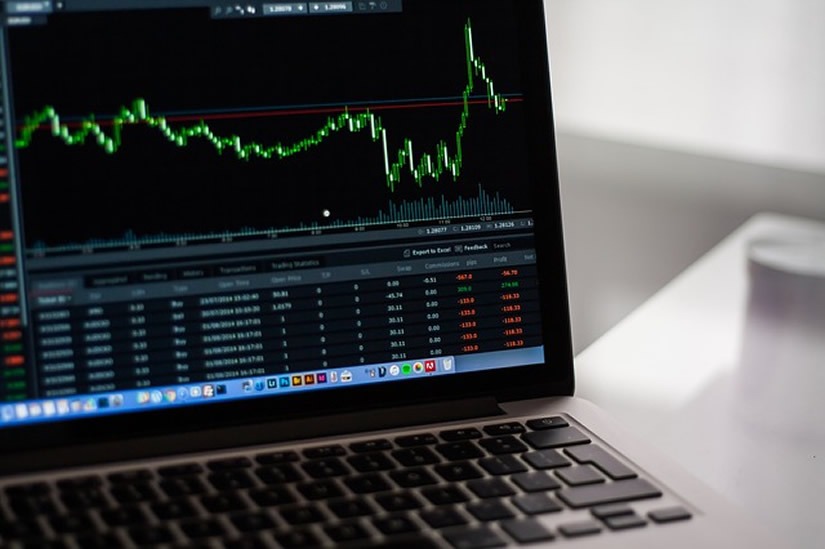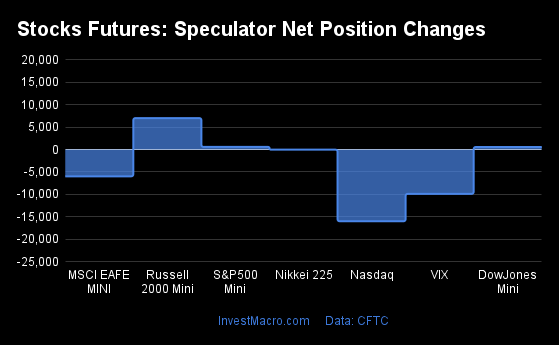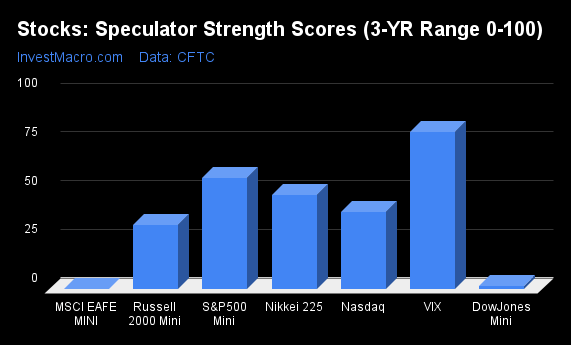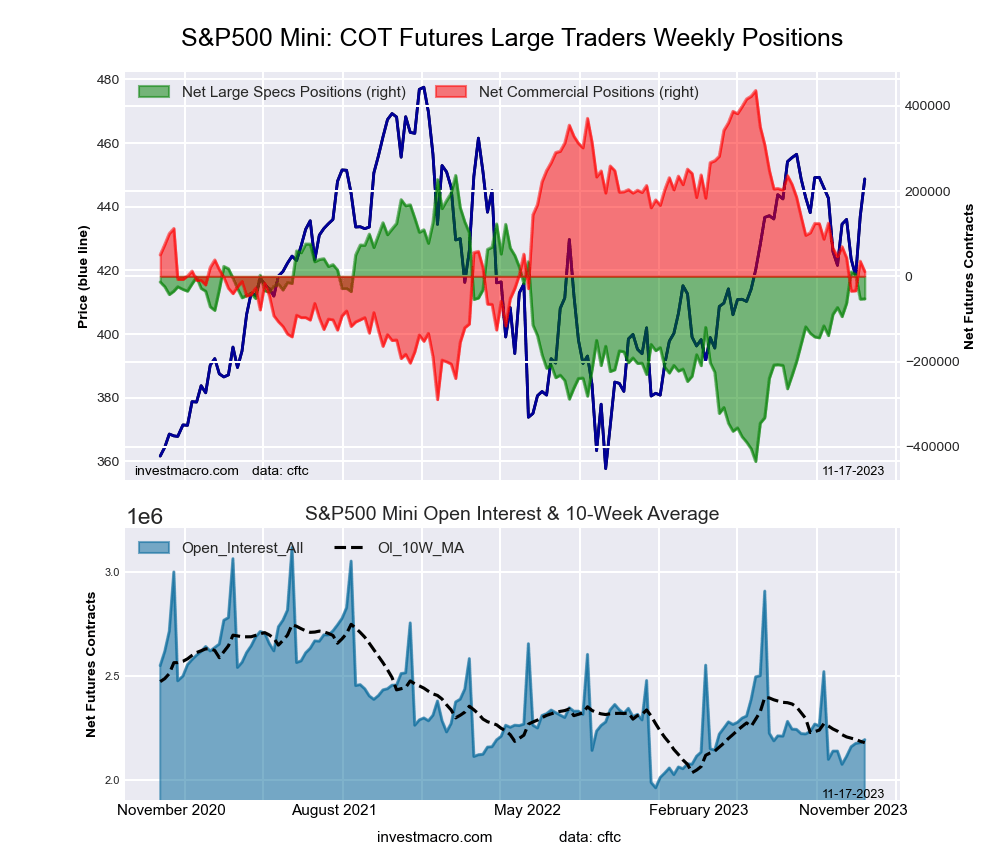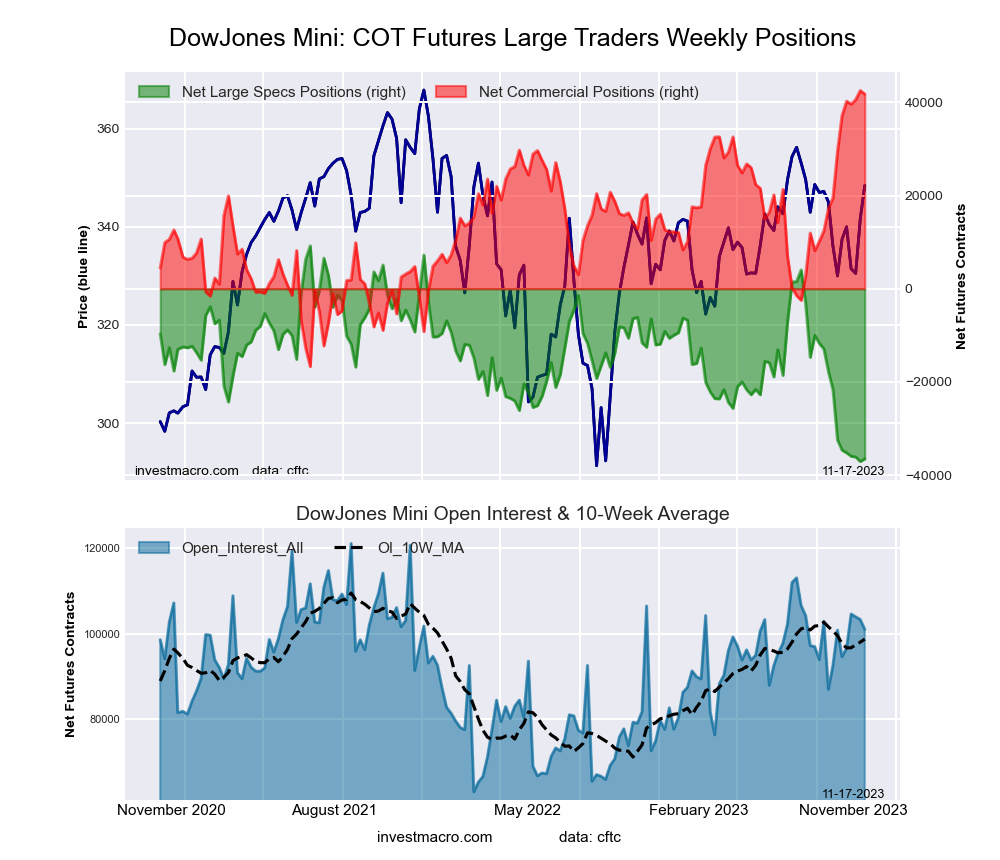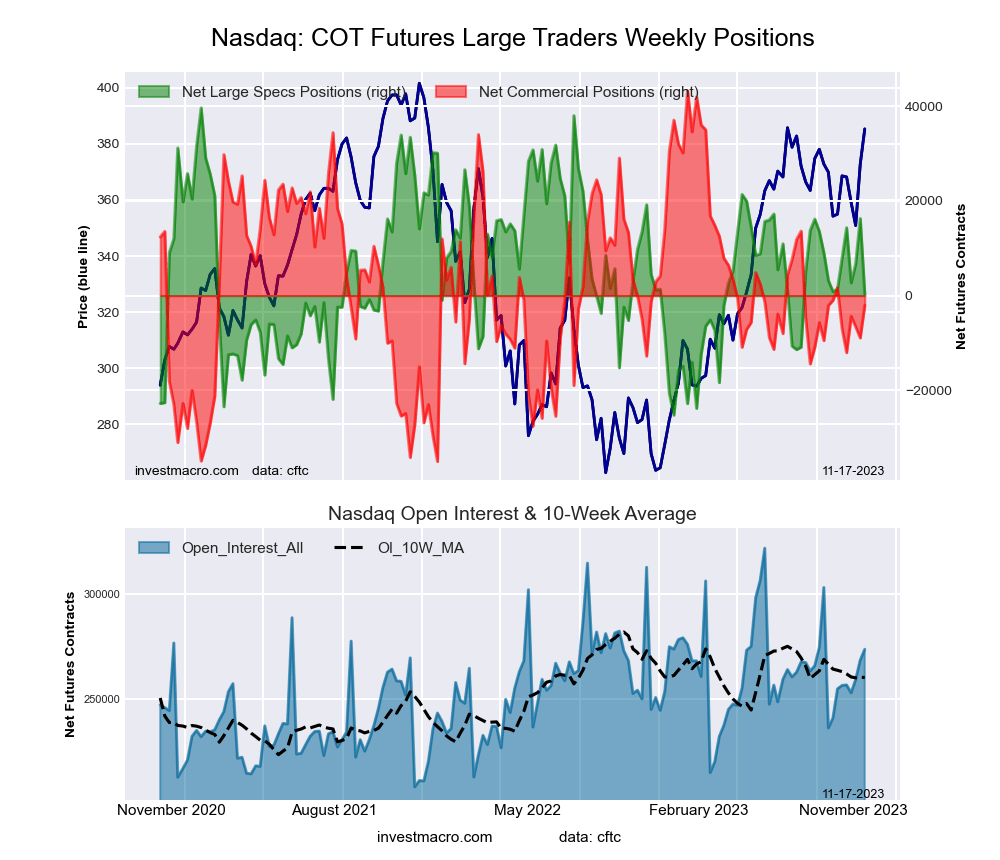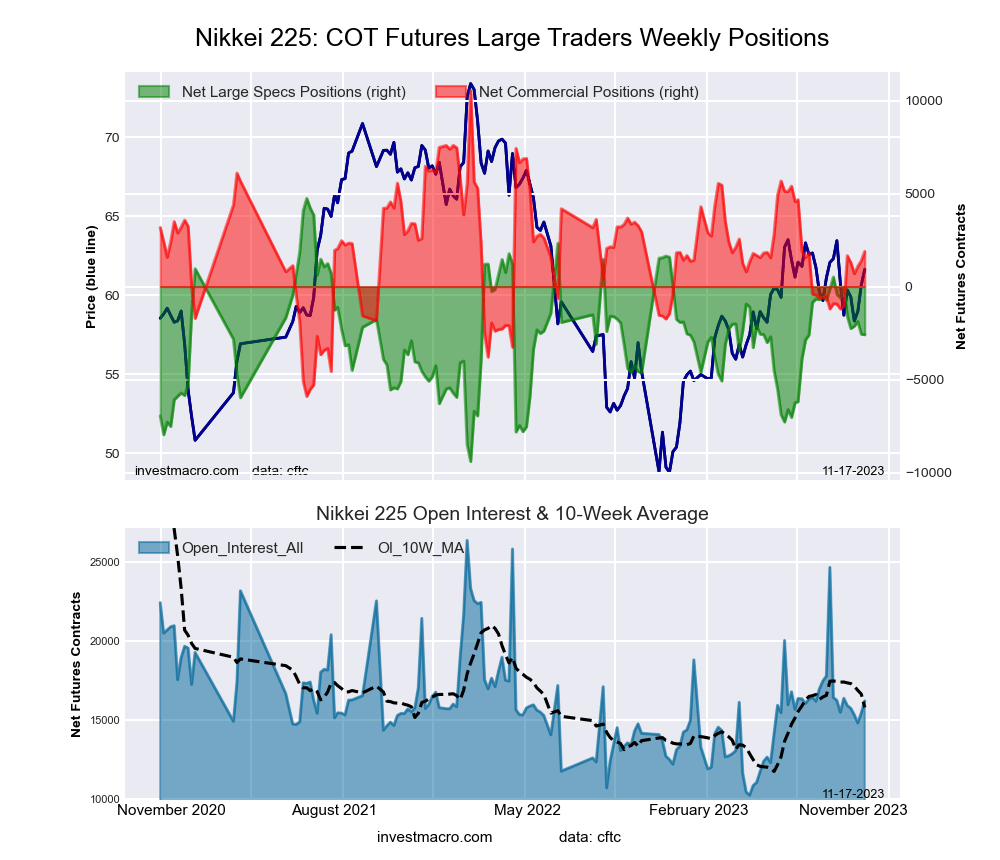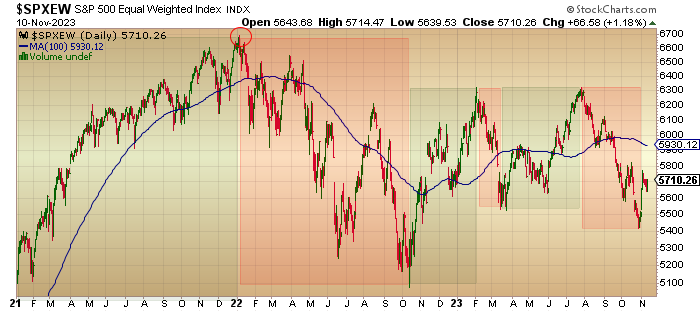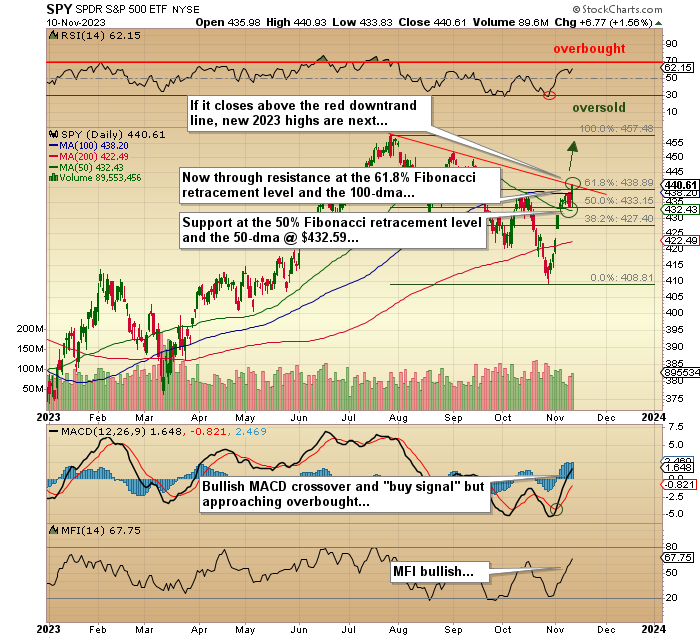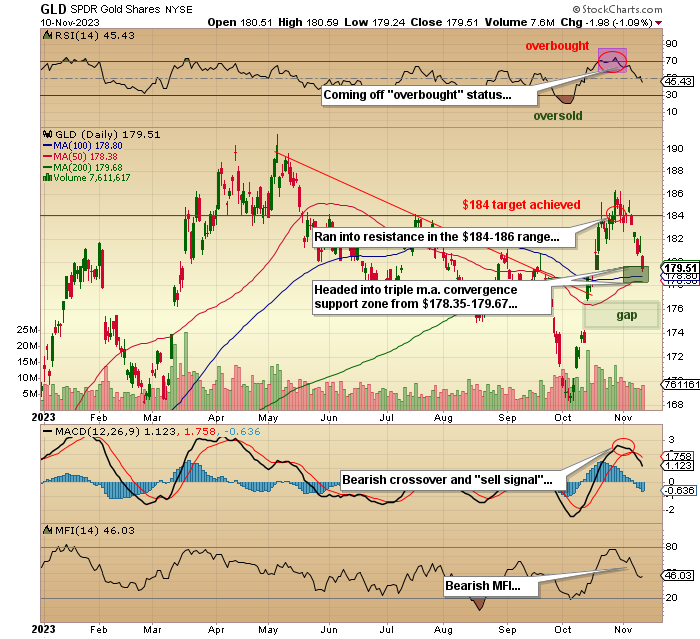By InvestMacro
Here are the latest charts and statistics for the Commitment of Traders (COT) data published by the Commodities Futures Trading Commission (CFTC).
The latest COT data is updated through Tuesday November 28th and shows a quick view of how large traders (for-profit speculators and commercial entities) were positioned in the futures markets.
Weekly Speculator Changes led by S&P500-Mini & DowJones-Mini
The COT stock markets speculator bets were higher this week as four out of the seven stock markets we cover had higher positioning while the other three markets had lower speculator contracts.
Leading the gains for the stock markets was the S&P500-Mini (15,053 contracts) with the DowJones-Mini (9,700 contracts), the Nasdaq-Mini (2,234 contracts) and the Russell-Mini (1,753 contracts) also showing positive weeks.
The markets with the declines in speculator bets this week were the MSCI EAFE-Mini (-3,786 contracts), the VIX (-105 contracts) and the Nikkei 225 (-121 contracts) also registering lower bets on the week.
Nov-28-2023 | OI | OI-Index | Spec-Net | Spec-Index | Com-Net | COM-Index | Smalls-Net | Smalls-Index |
|---|---|---|---|---|---|---|---|---|
| S&P500-Mini | 2,279,894 | 28 | -65,027 | 55 | 21,959 | 43 | 43,068 | 54 |
| VIX | 390,752 | 67 | -47,536 | 78 | 48,576 | 19 | -1,040 | 91 |
| Nasdaq-Mini | 293,315 | 75 | 7,278 | 50 | -10,902 | 31 | 3,624 | 81 |
| DowJones-Mini | 98,357 | 61 | -24,608 | 27 | 29,427 | 78 | -4,819 | 20 |
| Nikkei 225 Yen | 65,679 | 65 | 15,065 | 81 | 4,801 | 24 | -19,866 | 43 |
| Nikkei 225 | 17,204 | 43 | -2,360 | 50 | 1,504 | 45 | 856 | 39 |
Strength Scores led by the VIX
COT Strength Scores (a normalized measure of Speculator positions over a 3-Year range, from 0 to 100 where above 80 is Extreme-Bullish and below 20 is Extreme-Bearish) showed that the VIX (78 percent) leads the stock markets this week. The S&P500-Mini (55 percent) and the Nikkei 225 (50 percent) come in as the next highest in the weekly strength scores.
On the downside, the MSCI EAFE-Mini (2 percent) comes in at the lowest strength level currently and is in Extreme-Bearish territory (below 20 percent). The next lowest strength score is the DowJones-Mini (27 percent).
Strength Statistics:
VIX (77.5 percent) vs VIX previous week (77.6 percent)
S&P500-Mini (55.0 percent) vs S&P500-Mini previous week (52.8 percent)
DowJones-Mini (26.9 percent) vs DowJones-Mini previous week (6.0 percent)
Nasdaq-Mini (50.1 percent) vs Nasdaq-Mini previous week (46.7 percent)
Russell2000-Mini (42.1 percent) vs Russell2000-Mini previous week (41.0 percent)
Nikkei USD (49.8 percent) vs Nikkei USD previous week (50.7 percent)
EAFE-Mini (2.0 percent) vs EAFE-Mini previous week (5.4 percent)
DowJones-Mini tops the 6-Week Strength Trends
COT Strength Score Trends (or move index, calculates the 6-week changes in strength scores) showed that the DowJones-Mini (23 percent) leads the past six weeks trends for the stock markets.
The MSCI EAFE-Mini (-31 percent) leads the downside trend scores currently with the VIX (-16 percent) coming in as the next market with lower trend scores.
Strength Trend Statistics:
VIX (-16.5 percent) vs VIX previous week (-21.9 percent)
S&P500-Mini (-0.3 percent) vs S&P500-Mini previous week (2.1 percent)
DowJones-Mini (22.9 percent) vs DowJones-Mini previous week (0.7 percent)
Nasdaq-Mini (-10.9 percent) vs Nasdaq-Mini previous week (-4.3 percent)
Russell2000-Mini (-6.6 percent) vs Russell2000-Mini previous week (6.1 percent)
Nikkei USD (-0.7 percent) vs Nikkei USD previous week (-4.5 percent)
EAFE-Mini (-30.9 percent) vs EAFE-Mini previous week (-28.4 percent)
Individual Stock Market Charts:
VIX Volatility Futures:
 The VIX Volatility large speculator standing this week resulted in a net position of -47,536 contracts in the data reported through Tuesday. This was a weekly decrease of -105 contracts from the previous week which had a total of -47,431 net contracts.
The VIX Volatility large speculator standing this week resulted in a net position of -47,536 contracts in the data reported through Tuesday. This was a weekly decrease of -105 contracts from the previous week which had a total of -47,431 net contracts.
This week’s current strength score (the trader positioning range over the past three years, measured from 0 to 100) shows the speculators are currently Bullish with a score of 77.5 percent. The commercials are Bearish-Extreme with a score of 19.5 percent and the small traders (not shown in chart) are Bullish-Extreme with a score of 91.1 percent.
Price Trend-Following Model: Weak Uptrend (Possible Trend Change)
Our weekly trend-following model classifies the current market price position as: Weak Uptrend. The current action for the model is considered to be: Hold – Maintain Long Position.
| VIX Volatility Futures Statistics | SPECULATORS | COMMERCIALS | SMALL TRADERS |
| – Percent of Open Interest Longs: | 23.1 | 48.9 | 6.7 |
| – Percent of Open Interest Shorts: | 35.3 | 36.5 | 7.0 |
| – Net Position: | -47,536 | 48,576 | -1,040 |
| – Gross Longs: | 90,304 | 191,025 | 26,270 |
| – Gross Shorts: | 137,840 | 142,449 | 27,310 |
| – Long to Short Ratio: | 0.7 to 1 | 1.3 to 1 | 1.0 to 1 |
| NET POSITION TREND: | |||
| – Strength Index Score (3 Year Range Pct): | 77.5 | 19.5 | 91.1 |
| – Strength Index Reading (3 Year Range): | Bullish | Bearish-Extreme | Bullish-Extreme |
| NET POSITION MOVEMENT INDEX: | |||
| – 6-Week Change in Strength Index: | -16.5 | 11.2 | 38.0 |
S&P500 Mini Futures:
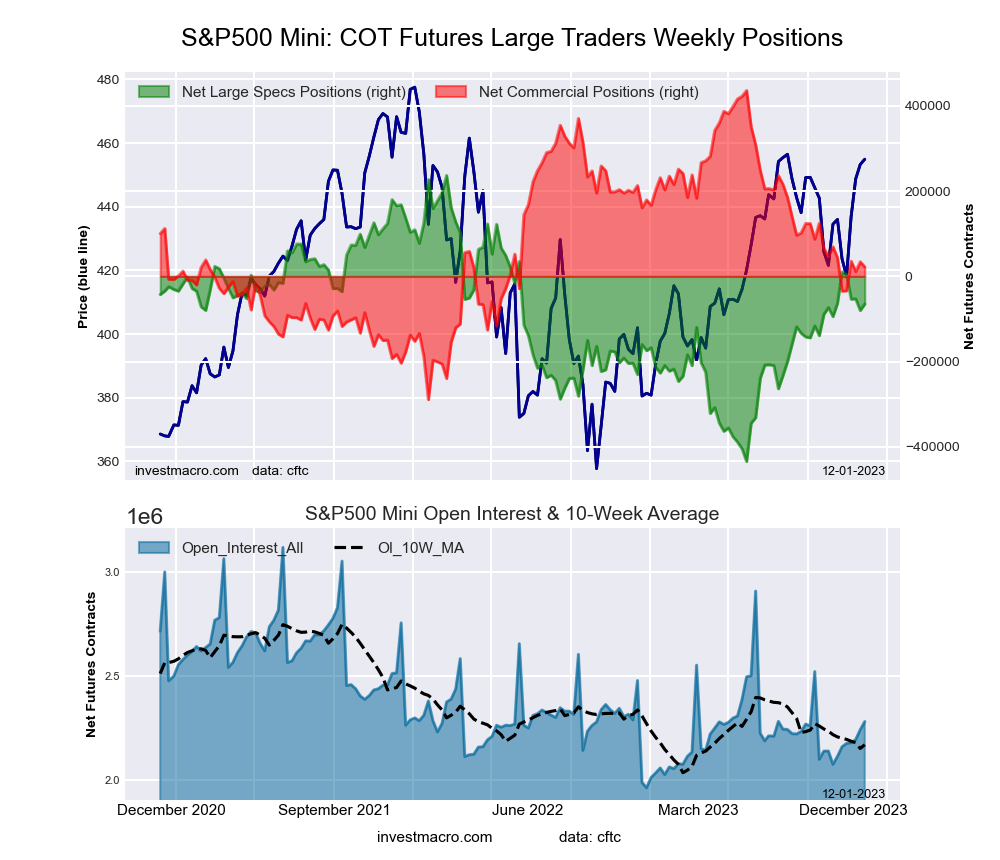 The S&P500 Mini large speculator standing this week resulted in a net position of -65,027 contracts in the data reported through Tuesday. This was a weekly lift of 15,053 contracts from the previous week which had a total of -80,080 net contracts.
The S&P500 Mini large speculator standing this week resulted in a net position of -65,027 contracts in the data reported through Tuesday. This was a weekly lift of 15,053 contracts from the previous week which had a total of -80,080 net contracts.
This week’s current strength score (the trader positioning range over the past three years, measured from 0 to 100) shows the speculators are currently Bullish with a score of 55.0 percent. The commercials are Bearish with a score of 42.9 percent and the small traders (not shown in chart) are Bullish with a score of 54.3 percent.
Price Trend-Following Model: Weak Downtrend (Possible Trend Change)
Our weekly trend-following model classifies the current market price position as: Weak Downtrend. The current action for the model is considered to be: Hold – Maintain Short Position.
| S&P500 Mini Futures Statistics | SPECULATORS | COMMERCIALS | SMALL TRADERS |
| – Percent of Open Interest Longs: | 12.4 | 73.3 | 11.4 |
| – Percent of Open Interest Shorts: | 15.2 | 72.3 | 9.5 |
| – Net Position: | -65,027 | 21,959 | 43,068 |
| – Gross Longs: | 281,709 | 1,671,401 | 258,805 |
| – Gross Shorts: | 346,736 | 1,649,442 | 215,737 |
| – Long to Short Ratio: | 0.8 to 1 | 1.0 to 1 | 1.2 to 1 |
| NET POSITION TREND: | |||
| – Strength Index Score (3 Year Range Pct): | 55.0 | 42.9 | 54.3 |
| – Strength Index Reading (3 Year Range): | Bullish | Bearish | Bullish |
| NET POSITION MOVEMENT INDEX: | |||
| – 6-Week Change in Strength Index: | -0.3 | -2.9 | 9.1 |
Dow Jones Mini Futures:
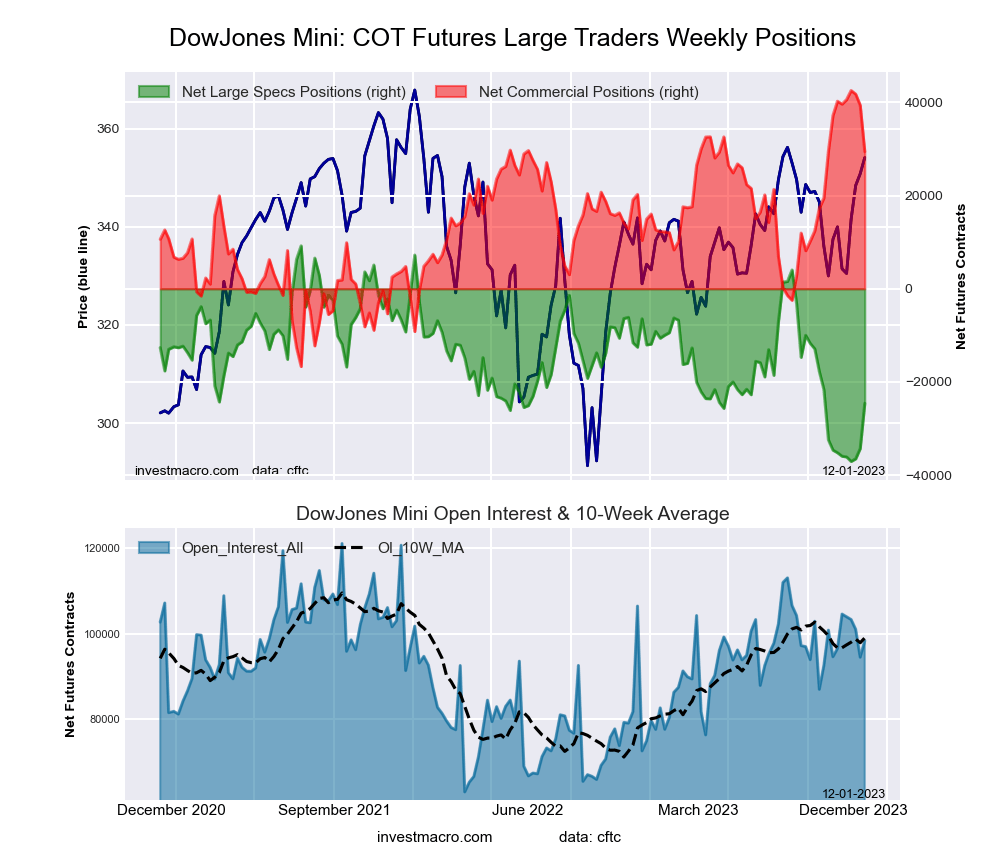 The Dow Jones Mini large speculator standing this week resulted in a net position of -24,608 contracts in the data reported through Tuesday. This was a weekly advance of 9,700 contracts from the previous week which had a total of -34,308 net contracts.
The Dow Jones Mini large speculator standing this week resulted in a net position of -24,608 contracts in the data reported through Tuesday. This was a weekly advance of 9,700 contracts from the previous week which had a total of -34,308 net contracts.
This week’s current strength score (the trader positioning range over the past three years, measured from 0 to 100) shows the speculators are currently Bearish with a score of 26.9 percent. The commercials are Bullish with a score of 77.8 percent and the small traders (not shown in chart) are Bearish with a score of 20.4 percent.
Price Trend-Following Model: Weak Downtrend (Possible Trend Change)
Our weekly trend-following model classifies the current market price position as: Weak Downtrend. The current action for the model is considered to be: Hold – Maintain Short Position.
| Dow Jones Mini Futures Statistics | SPECULATORS | COMMERCIALS | SMALL TRADERS |
| – Percent of Open Interest Longs: | 22.6 | 65.0 | 11.9 |
| – Percent of Open Interest Shorts: | 47.6 | 35.1 | 16.8 |
| – Net Position: | -24,608 | 29,427 | -4,819 |
| – Gross Longs: | 22,196 | 63,963 | 11,679 |
| – Gross Shorts: | 46,804 | 34,536 | 16,498 |
| – Long to Short Ratio: | 0.5 to 1 | 1.9 to 1 | 0.7 to 1 |
| NET POSITION TREND: | |||
| – Strength Index Score (3 Year Range Pct): | 26.9 | 77.8 | 20.4 |
| – Strength Index Reading (3 Year Range): | Bearish | Bullish | Bearish |
| NET POSITION MOVEMENT INDEX: | |||
| – 6-Week Change in Strength Index: | 22.9 | -18.3 | 1.1 |
Nasdaq Mini Futures:
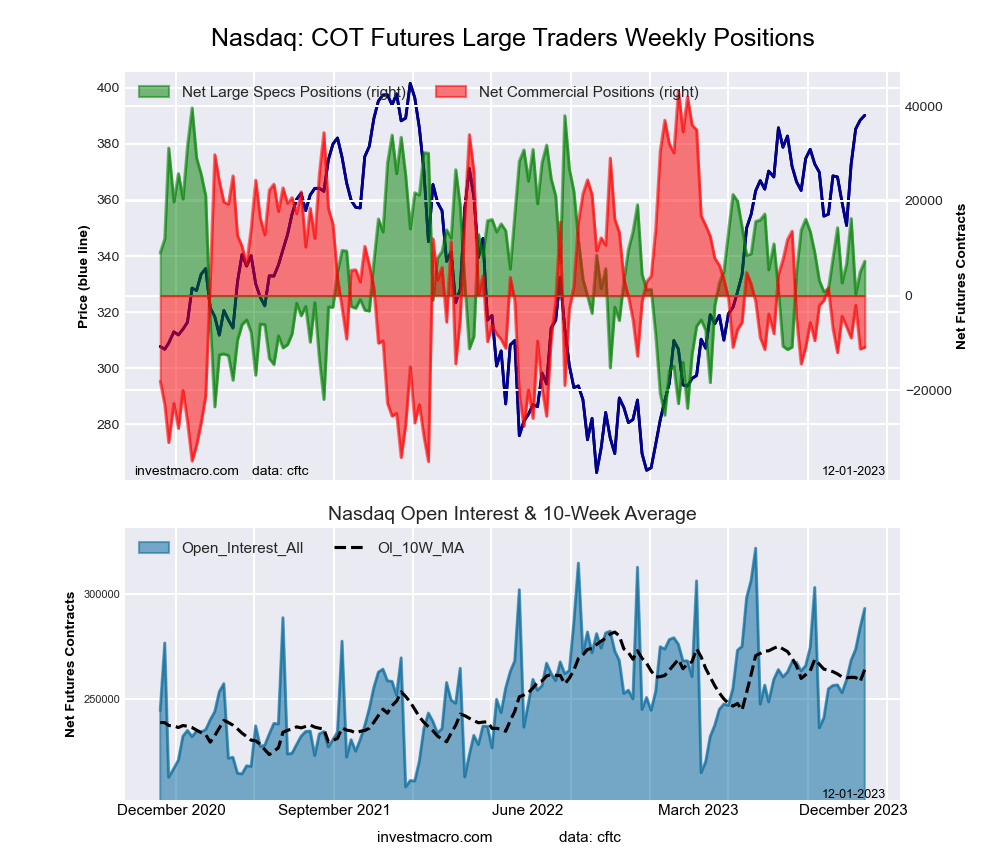 The Nasdaq Mini large speculator standing this week resulted in a net position of 7,278 contracts in the data reported through Tuesday. This was a weekly gain of 2,234 contracts from the previous week which had a total of 5,044 net contracts.
The Nasdaq Mini large speculator standing this week resulted in a net position of 7,278 contracts in the data reported through Tuesday. This was a weekly gain of 2,234 contracts from the previous week which had a total of 5,044 net contracts.
This week’s current strength score (the trader positioning range over the past three years, measured from 0 to 100) shows the speculators are currently Bullish with a score of 50.1 percent. The commercials are Bearish with a score of 30.8 percent and the small traders (not shown in chart) are Bullish-Extreme with a score of 81.4 percent.
Price Trend-Following Model: Strong Uptrend
Our weekly trend-following model classifies the current market price position as: Strong Uptrend. The current action for the model is considered to be: New Buy – Long Position.
| Nasdaq Mini Futures Statistics | SPECULATORS | COMMERCIALS | SMALL TRADERS |
| – Percent of Open Interest Longs: | 26.8 | 56.7 | 14.5 |
| – Percent of Open Interest Shorts: | 24.4 | 60.4 | 13.3 |
| – Net Position: | 7,278 | -10,902 | 3,624 |
| – Gross Longs: | 78,702 | 166,329 | 42,502 |
| – Gross Shorts: | 71,424 | 177,231 | 38,878 |
| – Long to Short Ratio: | 1.1 to 1 | 0.9 to 1 | 1.1 to 1 |
| NET POSITION TREND: | |||
| – Strength Index Score (3 Year Range Pct): | 50.1 | 30.8 | 81.4 |
| – Strength Index Reading (3 Year Range): | Bullish | Bearish | Bullish-Extreme |
| NET POSITION MOVEMENT INDEX: | |||
| – 6-Week Change in Strength Index: | -10.9 | 1.5 | 15.0 |
Russell 2000 Mini Futures:
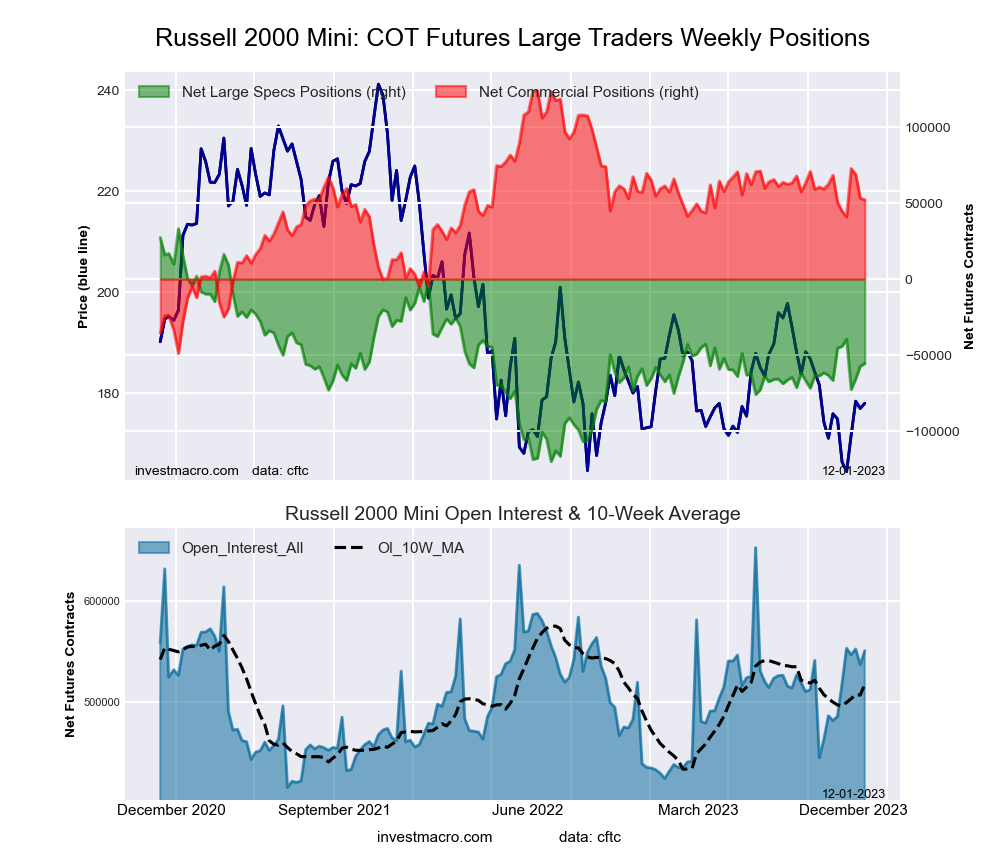 The Russell 2000 Mini large speculator standing this week resulted in a net position of -55,493 contracts in the data reported through Tuesday. This was a weekly increase of 1,753 contracts from the previous week which had a total of -57,246 net contracts.
The Russell 2000 Mini large speculator standing this week resulted in a net position of -55,493 contracts in the data reported through Tuesday. This was a weekly increase of 1,753 contracts from the previous week which had a total of -57,246 net contracts.
This week’s current strength score (the trader positioning range over the past three years, measured from 0 to 100) shows the speculators are currently Bearish with a score of 42.1 percent. The commercials are Bullish with a score of 58.4 percent and the small traders (not shown in chart) are Bearish with a score of 36.9 percent.
Price Trend-Following Model: Downtrend
Our weekly trend-following model classifies the current market price position as: Downtrend. The current action for the model is considered to be: Hold – Maintain Short Position.
| Russell 2000 Mini Futures Statistics | SPECULATORS | COMMERCIALS | SMALL TRADERS |
| – Percent of Open Interest Longs: | 13.7 | 80.6 | 4.9 |
| – Percent of Open Interest Shorts: | 23.7 | 71.1 | 4.2 |
| – Net Position: | -55,493 | 52,149 | 3,344 |
| – Gross Longs: | 75,264 | 444,001 | 26,746 |
| – Gross Shorts: | 130,757 | 391,852 | 23,402 |
| – Long to Short Ratio: | 0.6 to 1 | 1.1 to 1 | 1.1 to 1 |
| NET POSITION TREND: | |||
| – Strength Index Score (3 Year Range Pct): | 42.1 | 58.4 | 36.9 |
| – Strength Index Reading (3 Year Range): | Bearish | Bullish | Bearish |
| NET POSITION MOVEMENT INDEX: | |||
| – 6-Week Change in Strength Index: | -6.6 | 0.9 | 26.0 |
Nikkei Stock Average (USD) Futures:
 The Nikkei Stock Average (USD) large speculator standing this week resulted in a net position of -2,360 contracts in the data reported through Tuesday. This was a weekly fall of -121 contracts from the previous week which had a total of -2,239 net contracts.
The Nikkei Stock Average (USD) large speculator standing this week resulted in a net position of -2,360 contracts in the data reported through Tuesday. This was a weekly fall of -121 contracts from the previous week which had a total of -2,239 net contracts.
This week’s current strength score (the trader positioning range over the past three years, measured from 0 to 100) shows the speculators are currently Bearish with a score of 49.8 percent. The commercials are Bearish with a score of 45.0 percent and the small traders (not shown in chart) are Bearish with a score of 39.1 percent.
Price Trend-Following Model: Weak Downtrend
Our weekly trend-following model classifies the current market price position as: Weak Downtrend. The current action for the model is considered to be: Hold – Maintain Short Position.
| Nikkei Stock Average Futures Statistics | SPECULATORS | COMMERCIALS | SMALL TRADERS |
| – Percent of Open Interest Longs: | 13.1 | 65.1 | 21.5 |
| – Percent of Open Interest Shorts: | 26.8 | 56.4 | 16.5 |
| – Net Position: | -2,360 | 1,504 | 856 |
| – Gross Longs: | 2,250 | 11,204 | 3,693 |
| – Gross Shorts: | 4,610 | 9,700 | 2,837 |
| – Long to Short Ratio: | 0.5 to 1 | 1.2 to 1 | 1.3 to 1 |
| NET POSITION TREND: | |||
| – Strength Index Score (3 Year Range Pct): | 49.8 | 45.0 | 39.1 |
| – Strength Index Reading (3 Year Range): | Bearish | Bearish | Bearish |
| NET POSITION MOVEMENT INDEX: | |||
| – 6-Week Change in Strength Index: | -0.7 | 1.3 | -1.4 |
MSCI EAFE Mini Futures:
 The MSCI EAFE Mini large speculator standing this week resulted in a net position of -62,032 contracts in the data reported through Tuesday. This was a weekly reduction of -3,786 contracts from the previous week which had a total of -58,246 net contracts.
The MSCI EAFE Mini large speculator standing this week resulted in a net position of -62,032 contracts in the data reported through Tuesday. This was a weekly reduction of -3,786 contracts from the previous week which had a total of -58,246 net contracts.
This week’s current strength score (the trader positioning range over the past three years, measured from 0 to 100) shows the speculators are currently Bearish-Extreme with a score of 2.0 percent. The commercials are Bullish-Extreme with a score of 96.1 percent and the small traders (not shown in chart) are Bearish with a score of 40.9 percent.
Price Trend-Following Model: Weak Downtrend
Our weekly trend-following model classifies the current market price position as: Weak Downtrend. The current action for the model is considered to be: Hold – Maintain Short Position.
| MSCI EAFE Mini Futures Statistics | SPECULATORS | COMMERCIALS | SMALL TRADERS |
| – Percent of Open Interest Longs: | 4.8 | 91.4 | 3.0 |
| – Percent of Open Interest Shorts: | 20.0 | 77.3 | 1.9 |
| – Net Position: | -62,032 | 57,252 | 4,780 |
| – Gross Longs: | 19,593 | 372,693 | 12,373 |
| – Gross Shorts: | 81,625 | 315,441 | 7,593 |
| – Long to Short Ratio: | 0.2 to 1 | 1.2 to 1 | 1.6 to 1 |
| NET POSITION TREND: | |||
| – Strength Index Score (3 Year Range Pct): | 2.0 | 96.1 | 40.9 |
| – Strength Index Reading (3 Year Range): | Bearish-Extreme | Bullish-Extreme | Bearish |
| NET POSITION MOVEMENT INDEX: | |||
| – 6-Week Change in Strength Index: | -30.9 | 29.2 | 11.4 |
Article By InvestMacro – Receive our weekly COT Newsletter
*COT Report: The COT data, released weekly to the public each Friday, is updated through the most recent Tuesday (data is 3 days old) and shows a quick view of how large speculators or non-commercials (for-profit traders) were positioned in the futures markets.
The CFTC categorizes trader positions according to commercial hedgers (traders who use futures contracts for hedging as part of the business), non-commercials (large traders who speculate to realize trading profits) and nonreportable traders (usually small traders/speculators) as well as their open interest (contracts open in the market at time of reporting). See CFTC criteria here.

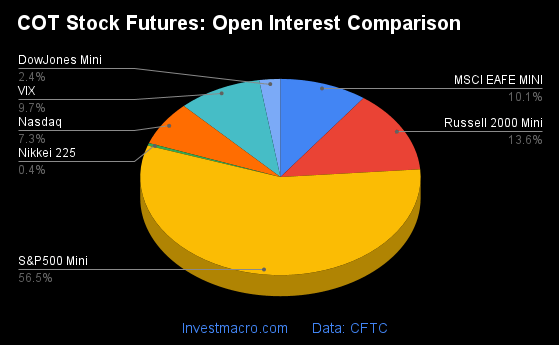



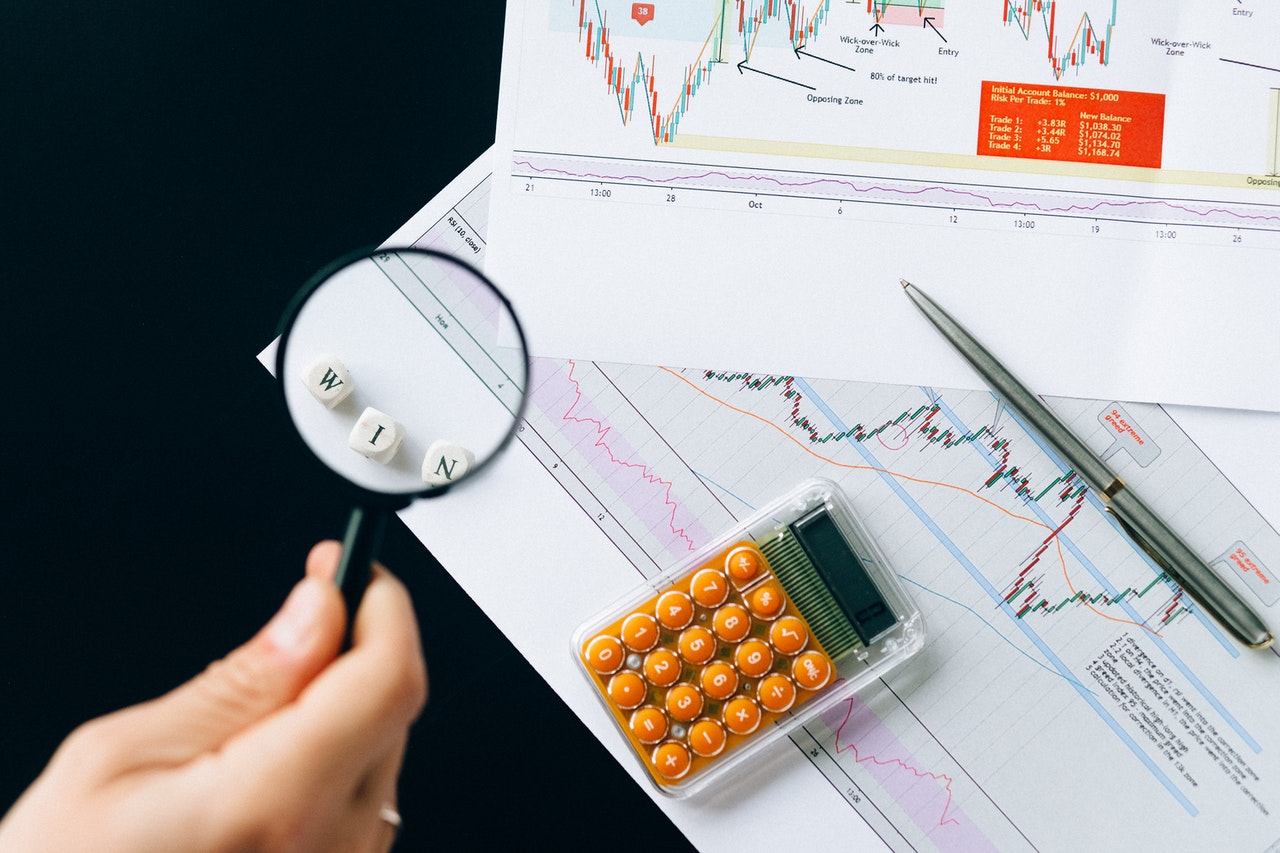


 Article by
Article by 











